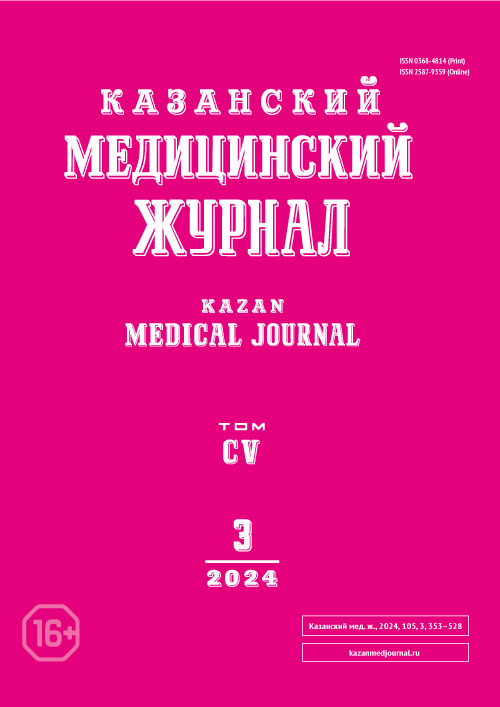Association of iron deficiency anemia with the development of paroxysms of atrial fibrillation within a year after pharmacological cardioversion with amiodarone
- Authors: Valeev M.K.1, Khasanov N.R.2
-
Affiliations:
- Pestrechinskaya central district hospital
- Kazan State Medical University
- Issue: Vol 105, No 3 (2024)
- Pages: 357-365
- Section: Theoretical and clinical medicine
- Submitted: 15.01.2024
- Accepted: 07.05.2024
- Published: 03.06.2024
- URL: https://kazanmedjournal.ru/kazanmedj/article/view/625660
- DOI: https://doi.org/10.17816/KMJ625660
- ID: 625660
Cite item
Abstract
BACKGROUND: Anemia is a common problem with atrial fibrillation. There is a limited number of studies examining the role of iron deficiency anemia in the course of atrial fibrillation.
AIM: To evaluate the association of iron deficiency anemia with the development of recurrent atrial fibrillation within 12 months in patients after pharmacological cardioversion with amiodarone.
MATERIAL AND METHODS: The study included 198 patients over 18 years of age [120 (60.6%) men and 78 (39.4%) women, median age 71 (63.2; 77) years] with paroxysmal non-valvular atrial fibrillation and duration of paroxysm <48 h, after successful pharmacological cardioversion with amiodarone. The group with anemia included 99 patients (all had iron deficiency anemia), the group without anemia included 99 people. Patients with anemia were older; the groups were comparable in other main indicators. The development of recurrent atrial fibrillation over 1 year of follow-up was assessed by the Kaplan–Meier method and the Cox proportional hazards model. Differences were considered statistically significant at a p value <0.05.
RESULTS: In the iron deficiency anemia group, symptomatic relapses of atrial fibrillation developed in 40.4% of patients during 1 year of observation; in the group without anemia — in 25.3% of patients (p=0.003). Kaplan–Meier analysis showed that iron deficiency anemia is associated with an increased risk of developing recurrent atrial fibrillation within 1 year after pharmacological cardioversion with amiodarone, relative risk 1.87 (p=0.014). Comparison of the risks associated with iron deficiency anemia and iron deficiency (regardless of the presence of anemia) showed a greater risk of recurrent atrial fibrillation associated with iron deficiency than with anemia (for interaction p=0.014).
CONCLUSION: A comparison of the risks of developing recurrent atrial fibrillation in patients with iron deficiency itself and in patients with iron deficiency anemia showed a greater influence on the prognosis of recurrent atrial fibrillation by the presence of iron deficiency.
Full Text
About the authors
Marat Kh. Valeev
Pestrechinskaya central district hospital
Author for correspondence.
Email: vmh89@mail.ru
ORCID iD: 0000-0002-0570-0220
MD, Director, Therapist, Cardiologist
Russian Federation, Pestretsy villageNiyaz R. Khasanov
Kazan State Medical University
Email: ybzp@mail.ru
ORCID iD: 0000-0002-7760-0763
SPIN-code: 2501-3397
MD, Dr. Sci. (Med.), Prof., Head of Depart., Depart. of Propaedeutic of Internal Diseases named after Prof. S.S. Zimnitsky
Russian Federation, KazanReferences
- Singer DE. Antithrombotic therapy to prevent stroke in patients with atrial fibrillation. Ann Intern Med. 2000;132(10):841–842. doi: 10.7326/0003-4819-132-10-200005160-00017
- Benjamin EJ, Wolf PA, D’Agostino RB, Silbershatz H. Impact of atrial fibrillation on the risk of death. Circulation. 1998; 98(10):946–952. doi: 10.1161/01.CIR.98.10.946
- Keskin M, Ural D, Altay S, Argan O, Börklü EB, Kozan Ö. Iron deficiency and hematinic deficiencies in atrial fibrillation: A new insight into comorbidities. Turk Kardiyol Dern Ars. 2018;46(2):103–110. doi: 10.5543/tkda.2018.51001
- Song S, Li G. The cardiomyopathy of iron deficiency anaemia. Cardiology. 2018;(6):92–98. doi: 10.33590/emjcardiol/10313387
- Berdoukas V, Coates TD, Cabantchik ZI. Iron and oxidative stress in cardiomyopathy in thalassemia. Free Radic Biol Med. 2015;88:3–9. doi: 10.1016/j.freeradbiomed.2015.07.019
- Maisel WH, Stevenson LW. Atrial fibrillation in heart failure: Epidemiology, pathophysiology, and rationale for therapy. Am J Cardiol. 2003;91:2–8. doi: 10.1016/S0002-9149(02)03373-8
- Puurunen M, Kiviniemi T, Nammas W. Impact of anemia on clinical outcome in patients with atrial fibrillation undergoing percutaneous coronary intervention: insights from the AFCAS registry. BMJ Open. 2014;4:e004700. doi: 10.1136/bmjopen-2013-004700
- Bonde AN, Blanche P, Staerk L. Oral anticoagulation among atrial fibrillation patients with anemia: An observational cohort study. Eur Heart J. 2019;40:3782–3790. doi: 10.1093/eurheartj/ehz155/542412
- Westenbrink BD, Alings M, Granger CB. Anemia is associated with bleeding and mortality, but not stroke, in patients with atrial fibrillation: Insights from the Apixaban for Reduction in Stroke and Other Thromboembolic Events in Atrial Fibrillation (ARISTOTLE) trial. Am Heart J. 2017;185:140–149. doi: 10.1016/j.ahj.2016.12.008
- Tu SJ, Hanna-Rivero N, Elliott AD. Associations of anemia with stroke, bleeding, and mortality in atrial fibrillation: A systematic review and meta-analysis. J Cardiovasc Electrophysiol. 2021;32:686–694. doi: 10.1111/jce.14898
- Hashimoto K, Kimura T, Ikemura N. Burden of mild (<13 g/dl) anemia in patients with atrial fibrillation (a report from a multicenter registry with patient-reported outcomes). Am J Cardiol. 2021;157:48–55. doi: 10.1016/j.amjcard.2021.06.045
- Woo-Hyun Lim, Eue-Keun Choi, Kyung-Do Han, So-Ryoung Lee, Myung-Jin Cha, Seil Oh. Impact of hemoglobin levels and their dynamic changes on the risk of atrial fibrillation: A nationwide population-based study. Sci Rep. 2020;10:6762. doi: 10.1038/s41598-020-63878-9
- Arakelyan MG, Bockeria LA, Vasilieva EYu, Golitsyn SP, Golukhova EZ, Gorev MV, Davtyan KV, Drapkina OM, Kropacheva ES, Kuchinskaya EA, Lajovich LYu, Mironov NYu, Mishina IE, Panchenko EP, Revishvili ASh, Rzayev FG, Tatarsky BA, Utsumueva MD, Shakhmatova OO, Shlevkov NB, Shpektor AV, Andreev DA, Artyukhina EA, Barbarash OL, Galyavich AS, Duplyakov DV, Zenin SA, Lebedev DS, Mikhailov EN, Novikova NA, Popov SV, Filatov AG, Shlyakhto EV, Shubik YuV. 2020 Clinical guidelines for Atrial fibrillation and atrial flutter. Russian Journal of Cardiology. 2021;26(7):4594 (In Russ.) doi: 10.15829/1560-4071-2021-4594
- World Health Organization World Health Organization. Haemoglobin concentrations for the diagnosis of anaemia and assessment of severity. 2011. Available from: https://www.jstor.org/stable/resrep41058/ Accessed: Jan 24, 2024.
- Sutil-Vega M, Rizzo M, Martinez-Rubio A. Anemia and iron deficiency in heart failure: A review of echocardiographic features. Echocardiography. 2019;36:585–594. doi: 10.1111/echo.14271
- Valeev MKh, Khasanov NR. Association of iron deficiency with atrial fibrillation recurrence after pharmacological cardioversion. Russian Journal of Cardiology. 2023;28(2S):5369. (In Russ.) doi: 10.15829/1560-4071-2023-5369
Supplementary files








